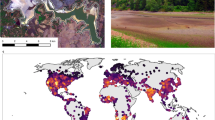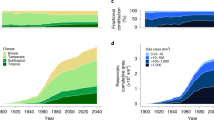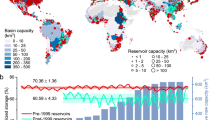Abstract
Hydroelectric reservoirs cover an area of 3.4×105 km2 and comprise about 20% of all reservoirs. In addition, they contain large stores of formerly terrestrial organic carbon. Significant amounts of greenhouse gases are emitted2, especially in the early years following reservoir creation, but the global extent of these emissions is poorly known. Previous estimates of emissions from all types of reservoir indicate that these human-made systems emit 321 Tg of carbon per year (ref. 4). Here we assess the emissions of carbon dioxide and methane from hydroelectric reservoirs, on the basis of data from 85 globally distributed hydroelectric reservoirs that account for 20% of the global area of these systems. We relate the emissions to reservoir age, location biome, morphometric features and chemical status. We estimate that hydroelectric reservoirs emit about 48 Tg C as CO2 and 3 Tg C as CH4, corresponding to 4% of global carbon emissions from inland waters. Our estimates are smaller than previous estimates on the basis of more limited data. Carbon emissions are correlated to reservoir age and latitude, with the highest emission rates from the tropical Amazon region. We conclude that future emissions will be highly dependent on the geographic location of new hydroelectric reservoirs.
This is a preview of subscription content, access via your institution
Access options
Subscribe to this journal
Receive 12 print issues and online access
$259.00 per year
only $21.58 per issue
Buy this article
- Purchase on Springer Link
- Instant access to full article PDF
Prices may be subject to local taxes which are calculated during checkout



Similar content being viewed by others
Change history
02 August 2011
In the version of this Letter originally published online, in the second sentence of the first paragraph of the main text, it should have read "...annual rise of the global sea level of 0.55 mm". This has now been corrected in all versions of the Letter.
17 August 2011
In the version of this Letter originally published online, we wish to clarify that the emission estimate of 321 Tg of carbon per year referred to in the first paragraph was from all types of reservoir. In the penultimate line of the caption for Fig. 3, '+0.39 DOC' should have read '+0.39 log DOC'. The Supplementary Information also contained several minor errors. All versions of the Letter and the Supplementary Information have been corrected.
References
Chao, B. F., Wu, Y. H. & Li, Y. S. Impact of artificial reservoir water impoundment on global sea level. Science 320, 212–214 (2008).
Rudd, J. W. M., Harris, R., Kelly, C. A. & Hecky, R. E. Are hydroelectric reservoirs significant sources of greenhouse gases? Ambio 22, 246–248 (1993).
Pircher, W. 36000 dams and still more needed. Intern. Water Power Dam Construction 45, 15–18 (1993).
St Louis, V. L., Kelly, C. A., Duchemin, E., Rudd, J. W. M. & Rosenberg, D. M. Reservoir surfaces as sources of greenhouse gases to the atmosphere: A global estimate. Bioscience 50, 766–775 (2000).
Giles, J. Methane quashes green credentials of hydropower. Nature 444, 524–525 (2006).
Abril, G. et al. Carbon dioxide and methane emissions and the carbon budget of a 10-year old tropical reservoir (Petit Saut, French Guiana). Glob. Biogeochem. Cycles 19, GB4007 (2005).
Teodoru, C., Prairie, Y. & del Giorgio, P. Spatial heterogeneity of surface CO2 fluxes in a newly created Eastmain-1 reservoir in Northern Quebec, Canada. Ecosystems 14, 28–46 (2010).
Fearnside, P. M. Brazil’s Samuel Dam: Lessons for hydroelectric development policy and the environment in Amazonia. Environ. Manage. 35, 1–19 (2005).
DelSontro, T., McGinnis, D. F., Sobek, S., Ostrovsky, I. & Wehrli, B. Extreme methane emissions from a Swiss hydropower reservoir: Contribution from bubbling sediments. Environ. Sci. Technol. 44, 2419–2425 (2010).
Tremblay, A., Lambert, M. & Gagnon, L. Do hydroelectric reservoirs emit greenhouse gases? Environ. Manage. 33, S509–S517 (2004).
Santos, M. A., Rosa, L. P., Sikar, B., Sikar, E. & Dos Santos, E. O. Gross greenhouse gas fluxes from hydro-power reservoir compared to thermo-power plants. Energy Policy 34, 481–488 (2004).
Kosten, S. et al. Climate-dependent CO2 emissions from lakes. Glob. Biogeochem. Cycles 24, GB2007 (2010).
Galy-Lacaux, C., Delmas, R., Kouadio, G., Richard, S. & Gosse, P. Long-term greenhouse gas emissions from hydroelectric reservoirs in tropical forest regions. Glob. Biogeochem. Cycles 13, 503–517 (1999).
Bastviken, D., Cole, J., Pace, M. & Tranvik, L. Methane emissions from lakes: Dependence of lake characteristics, two regional assessments, and a global estimate. Glob. Biogeochem. Cycles 18, GB4009 (2004).
Roland, F. et al. Variability of carbon dioxide flux from tropical (Cerrado) hydroelectric reservoirs. Aquat. Sci. 72, 283–293 (2010).
Kemenes, A., Forsberg, B. R. & Melack, J. M. Methane release below a tropical hydroelectric dam. Geophys. Res. Lett. 34, L12809 (2007).
Guerin, F. et al. Methane and carbon dioxide emissions from tropical reservoirs: Significance of downstream rivers. Geophys. Res. Lett. 33, L21407 (2006).
IPCC Climate Change 2007: Synthesis Report (eds Pachauri, R. K. & Reisinger, A.) (IPCC, 2007).
Cole, J. J. et al. Plumbing the global carbon cycle: Integrating inland waters into the terrestrial carbon budget. Ecosystems 10, 171–184 (2007).
Tranvik, L. J. et al. Lakes and reservoirs as regulators of carbon cycling and climate. Limnol. Oceanogr. 54, 2298–2314 (2009).
Soumis, N., Duchemin, E., Canuel, R. & Lucotte, M. Greenhouse gas emissions from reservoirs of the western United States. Glob. Biogeochem. Cycles 18, GB3022 (2004).
Bastviken, D., Tranvik, L. J., Downing, J. A., Crill, P. M. & Enrich-Prast, A. Freshwater methane emissions offset the continental carbon sink. Science 331, 50 (2011).
Acknowledgements
We thank F. Pacheco, R. Almeida and D. Torsten for searching data to improve our database. We are grateful to A. Cimbleris for inspiring us with insights connecting science and societal needs and to R. Mendonça and J. Ometto for critical discussion and reading of the manuscript. This work was supported by grants from FURNAS Centrais Elétricas and from the Swedish Foundation for International Cooperation in Research and Higher Education (STINT). V.L.M.H. and F.R. are partially supported by Conselho Nacional de Investigação Científica e Tecnológica (CNPq), Brasil.
Author information
Authors and Affiliations
Contributions
F.R., J.J.C., L.J.T. and D.B. contributed to study design. N.B. and F.R. mined data. N.B., F.R., J.J.C. and Y.T.P. analysed the data. N.B., J.J.C., L.J.T., V.L.M.H., P.d.G. and F.R. wrote major portions of the manuscript. Y.T.P. and N.B. carried out and refined other statistical analyses. All authors discussed the results and commented on the manuscript.
Corresponding author
Ethics declarations
Competing interests
The authors declare no competing financial interests.
Supplementary information
Supplementary Information
Supplementary Information (PDF 636 kb)
Rights and permissions
About this article
Cite this article
Barros, N., Cole, J., Tranvik, L. et al. Carbon emission from hydroelectric reservoirs linked to reservoir age and latitude. Nature Geosci 4, 593–596 (2011). https://doi.org/10.1038/ngeo1211
Received:
Accepted:
Published:
Issue Date:
DOI: https://doi.org/10.1038/ngeo1211
This article is cited by
-
River ecosystem metabolism and carbon biogeochemistry in a changing world
Nature (2023)
-
Sediment and Nutrient Trapping by River Dams: A Critical Review Based on 15-Year Big Data
Current Pollution Reports (2023)
-
Changing temporal and spatial patterns of methane emission from rivers by reservoir dams: a review
Environmental Science and Pollution Research (2023)
-
Greenhouse gas emissions from hydroelectric reservoirs: mechanistic understanding of influencing factors and future prospect
Environmental Science and Pollution Research (2023)
-
Florida’s urban stormwater ponds are net sources of carbon to the atmosphere despite increased carbon burial over time
Communications Earth & Environment (2022)



